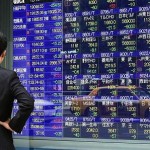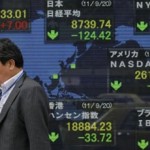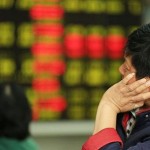Asia markets rally after oil prices surge on OPEC production cut deal

The overnight rally in oil prices amid reports that oil producers finally agreed to cut production levels sent Asia markets higher on Thursday.
Australia’s ASX 200 was up 1 percent in afternoon trade, with the energy sector rallying 6.54 percent, while the materials sector gained 3 percent.
The Australian dollar, which is influenced by moves in oil prices, climbed from levels near $0.7650 in the overnight session to as high as $0.7710 on Thursday morning local time. As of 12:58 p.m. HK/SIN, the Aussie traded a touch lower at $0.7683.
Stephen Innes, a senior trader at OANDA, said on Thursday that while the bounce in commodities helped to push the Aussie dollar higher, sentiment is also “underpinned by a growing consensus that the Reserve Bank of Australia will remain on hold for the foreseeable future.”
This, Innes said, underscored the market’s view of the Aussie as a “safe haven high yielder.”
In Japan, the Nikkei 225 rallied 1.48 percent, while the Topix index was up 1.09 percent. Across the Korean Strait, the Kospi advanced 0.85 percent. Hong Kong’s Hang Seng index was up 0.48 percent. Mainland Chinese markets were also higher, with the Shanghai composite up 0.56 percent and the Shenzhen composite adding 0.64 percent.
Oil prices climbed sharply on Wednesday in the U.S., after Reuters reported OPEC members had reached an agreement to limit production to a range of 32.5 million to 33.0 million barrels per day, down slightly on August’s output of 33.2 million barrels a day.
The agreement, reportedly made at an informal meeting held on the sidelines of the International Energy Forum in Algiers, was a surprise. The meeting had been expected to end in stalemate over how to address a global oil supply glut which has hammered prices over the past two years. Reuters reported that OPEC would finalize an output reduction plan at its official meeting on November 30.
There was some skepticism among analysts around the limited details of the agreement, with some noting that the concessions offered by Saudi Arabia were a reflection that the world’s largest crude exporter was getting pinched by its own policy.
Wells Fargo Funds’ chief portfolio strategist, Brian Jacobsen, told CNBC’s “Squawk Box” on Thursday morning, “They got something on paper, but let’s see how enforceable it is.”
Jacobsen pointed out the deal wasn’t really an agreement to cut production; it was labelled as an understanding. “They agreed to agree, which is better than they did last year, where they couldn’t even agree to disagree on production levels.”
“It’s important from a signalling perspective, as far as how did the market react to this. Obviously, it went up. They like to see that. Maybe seeing this market reaction makes them realize that they actually have to come to that formal agreement and allocate the quotas appropriately,” he said.
Some analysts agreed that Wednesday’s agreement could be laying the ground works for a formal production cut deal at OPEC’s next meeting later this year.
“OPEC has indeed set the stage for a decisive oil deal in November, following the conclusion made in its informal meeting,” said analysts at Singapore’s OCBC Bank, adding there was expectation for a more comprehensive assessment and action by OPEC to deliver a plan to accelerate the rebalancing [of oil prices] story then.
During Asian hours on Thursday, oil retreated slightly. U.S. crudefutures fell 0.11 percent at $47.00 a barrel, as of 12:59 p.m. HK/SIN, after climbing 5.3 percent during the U.S. session on Wednesday.
Global benchmark Brent was down 0.45 percent at $48.47 a barrel, following an overnight gain of 5.9 percent to $48.69 a barrel.
The slightly pullback in oil prices did not appear to dampen sentiment among Asian energy names, as they rallied sharply. In Australia, Santosshares climbed 7.77 percent, Oil Search advanced 7.34 percent,Woodside Petroleum gained 7.62 percent and Beach Energy was up 12.08 percent.
Japan’s Inpex advanced 6.43 percent, Japan Petroleum climbed 9.51 percent and Cosmo Energy was up 4.55 percent. Fuji Oil, however, bucked the trend to trade lower by 1.91 percent. South Korea’s S-Oilwas up 3.23 percent, while Hong Kong-listed Chinese oil names also climbed, with shares of CNOOC up 5.93 percent, Petrochina advancing 3.82 percent and Sinopec up 4.58 percent.
The broader currency market saw limited movement in the dollar index, which measures the greenback against a basket of currencies, on Thursday. As of 1:04 p.m. HK/SIN, the dollar index traded at 95.413, only marginally higher than its previous close at 95.431.
U.S. Federal Reserve Chair Janet Yellen told Congress on Wednesdaythe central bank did not have a “fixed timetable” for removing the current accommodative stance. Her testimony followed the Fed’s decision last week to hold steady on the federal funds rate at 0.25 percent to 0.5 percent.
The Japanese yen retreated to 101.40 against the dollar, compared with levels as high as 100.23 in Asian hours on Wednesday.
OANDA’s Innes, however, cautioned that pessimism over the dollar/yen pair remained high, despite the yen’s relative weakening. He said, “We are likely to see traders continue to sell [the currency pair] into rallies.”
“Despite the growing pessimism, the pair has remained relatively resilient as there is some debate among dealers that a move below 100 yen will increase the likelihood of intervention. This shift is up from a consensus of 95 yen, as suspicions reign that the Ministry of Finance may step up their game after the Bank of Japan failed to ease at the last meeting,” he added.
Yen weakness sent Japanese export stocks higher, with Toyota shares up 0.87 percent, Honda rallying 1.61 percent and Canon adding 1.71 percent. A weaker yen is a positive for exporters as it expands their overseas profit numbers when converted into local currency.
Before market open, government data showed Japan’s retail sales fell 2.1 percent on-year in August, which was more than a Reuters’ median market forecast for a 1.8 percent drop.
The move in oil pushed U.S. stocks higher, with the Dow Jones industrial average rising 110.94 points, or 0.61 percent, to 18,339.24. TheS&P 500 index was up 11.44 points, or 0.53 percent, at 2,171.37, while the Nasdaq advanced 12.84 points, or 0.24 percent, to 5,318.55.
Source: CNBC





























